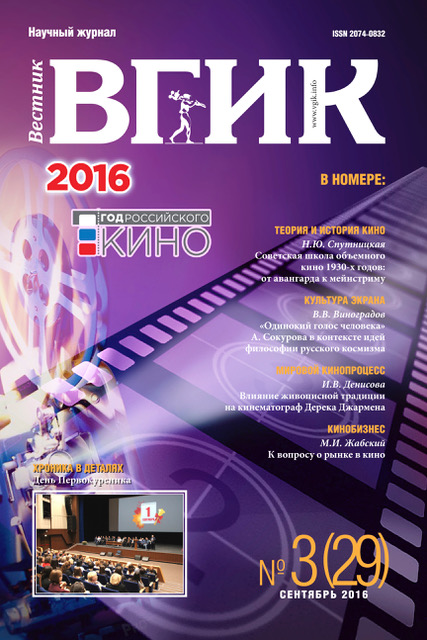Том 8, № 3 (2016)
- Год: 2016
- Статей: 16
- URL: https://journals.eco-vector.com/2074-0832/issue/view/877
- DOI: https://doi.org/10.17816/VGIK83
ХРОНИКА В ДЕТАЛЯХ | АКТУАЛЬНОЕ СОБЫТИЕ
ДЕНЬ ПЕРВОКУРСНИКА
 6-6
6-6


ТЕОРИЯ И ИСТОРИЯ КИНО | ЭКРАННЫЕ ИСКУССТВА
Советская школа объемного кино 1930-х годов: от авангарда к мейнстриму
Аннотация
Оценки отечественной анимации 1930-х долгое время носили снисходительный оттенок; историки кино, режиссеры, художники маркировали этот период эпохой безвременья, формализма и подражания диснеевской эстетике. Однако рассматриваемые фильмы сыграли значительную роль в развитии мирового кинопроцесса, в частности оказали влияние на формирование чешской, польской, украинской кукольной анимации послевоенных лет. К сожалению, некоторые работы Объединения объемных фильмов «Мосфильма» под руководством А.Л. Птушко утрачены, и в данный момент не удается точно установить, сколько именно картин было выпущено. В статье анализируются экспериментальные анимационные фильмы второй половины 1930-х годов, сохранившиеся на кинопленках, а также в виде монтажных листов (РГАЛИ, «Мосфильм», «Госфильмофонд»).
 8-18
8-18


Развитие жанра анимационного плаката в первой половине XX века
Аннотация
Предмет исследования - жанр анимационного плаката. В статье рассматривается развитие анимационного плаката в исторической перспективе от первых киноплакатов 1899 года до фильмов-плакатов периода Второй мировой войны. Анализируются причины, приводящие к смене функций и задач анимационного плаката, методов и приемов создания художественного образа.
 19-33
19-33


КИНОЯЗЫК И ВРЕМЯ | ГЕНЕЗИС ОБРАЗА
Документальное кино, XXI век: время подводить итоги
Аннотация
В статье исследуется творческое направление современного отечественного кинематографа, которое последние годы определяло тематическую, жанровую и стилистическую составляющую документальных фильмов, отмеченных призами российских и международных кинофестивалей.
 36-46
36-46


ПЕРФОРМАНС | ИСКУССТВО ВОПЛОЩЕНИЯ
Эстетика калейдоскопа в визуальных медиа
Аннотация
Во второй части статьи (начало см. в № 2 (28), 2016) рассматриваются особенности структуры калейдоскопического изображения, его культурологическое восприятие. Также продолжено исследование основных сюжетов, к которым обращаются фотографы, в частности, архитектурных сюжетов, и анализируются калейдоскопические эксперименты в области видео и мультимедиа.
 48-56
48-56


КУЛЬТУРА ЭКРАНА | КУЛЬТУРОЛОГИЯ. ФИЛОСОФИЯ
«Одинокий голос человека» A. Сокурова в контексте идей философии русского космизма
Аннотация
Статья посвящена первой совместной работе режиссера А. Сокурова и сценариста Ю. Арабова ««Одинокий голос человека», поставленной по мотивам произведений А. Платонова. В статье анализируются образная система фильма, его основные концепты в контексте художественно-философской системы А. Платонова и философии «общего дела» Н. Федорова. Рассматриваются основные библейские аллюзии произведения.
 58-71
58-71


Проблема изобразительной формы и задачи художественной педагогики
Аннотация
В статье на основе анализа ряда положений теорий А. Гильдебранда и Г. Вёльфлина рассматривается центральная задача преподавания изобразительного искусства, которая может быть положена в основу обучения как в классической академической школе, так и в школах современного искусства. В статье показано, что мнимое противопоставление главного предмета обучения - изображения предметной телесности и выражения художественного отношения - может быть преодолено, если положить в основу обучения видение глубинной изобразительной сущности явления и поиск формы ее показа.
 72-82
72-82


МИРОВОЙ КИНОПРОЦЕСС | АНАЛИЗ
Влияние живописной традиции на кинематограф Дерека Джармена
Аннотация
Статья посвящена выявлению интертекстуальных отсылок к живописным произведениям в художественных фильмах британского режиссера Дерека Джармена (1942-1994). В работе анализируются разнообразные интертекстуальные включения - от прямых цитаций до реминисценций.
 84-94
84-94


Специфика художественного метода в экранной документалистике США 1960-2000-х годов
Аннотация
В статье рассматриваются особенности художественного метода американского документалиста Ф. Уайзмена. Ставится также вопрос о развитии метода наблюдения в кино, основываясь на фильмах Р. Дрю и Р. Ликока, основоположников направления ««прямое кино», и о переходе этого метода к его зрелым формам, представленным работами Уайзмена. Найденные режиссером творческие приемы позволили заложить основы для современной зарубежной документалистики.
 95-105
95-105


Индийский кинематограф: прошлое и настоящее
Аннотация
В статье приводится краткий обзор истории развития индийского популярного кинематографа, выявляются основные вехи его эволюции, фиксируются этапы, для которых характерны различные сюжетные построения и особенности, идейное внутреннее наполнение.
 106-114
106-114


Преступник как главный киногерой, или Старые темы и новые решения
Аннотация
Статья посвящена анализу ряда австралийских фильмов, главные герои которых прототипы реально существовавших преступников, убийц, грабителей маньяков... Некоторых из них народное сознание возвело в ряд мучеников, как это случилось с Недом Келли, повешенным за грабеж. Только сегодня в Австралию приходит понимание, что преступность - болезнь общества, и режиссеры в своих картинах показывают процесс «взросления нации».
 115-125
115-125


КИНОБИЗНЕС | СТРАТЕГИЯ И ТАКТИКА УПРАВЛЕНИЯ
К вопросу о рынке в кино
Аннотация
Рассматриваются роль рынка в рождении кинематографа, отношение государства царской России к продукту рыночного кинопроизводства, признание Советским государством огромных возможностей кино как средства социальных изменений и их использование в новой постановке кинодела, исключавшей, но полностью и не упразднявшей рыночные отношения. На статистическом материале 1976 и 1986 годов проверена гипотеза о рентабельности советского кинематографа. Затронута концептуальная проблематика, возникшая при повороте к легитимному социалистическому рынку в середине 1980-х и связанная с развитием рыночных отношений в сегодняшнем кино.
 128-140
128-140


ТЕЛЕВИДЕНИЕ | ЦИФРОВАЯ СРЕДА
Визуализация как способ вовлечения в телерекламу
Аннотация
В статье рассматривается визуализация как способ вовлечения зрителей в телерекламу. Начиная с исторических форм демонстрации товара на площадках обмена, его презентация содержала регулятивный посыл. Максимально такая форма стала присущей телевидению с его изобразительными средствами. Это показало силу демонстрации процесса использования продукта. Глубинная тенденция, которая имела здесь место, это символическая нагрузка товара, увеличение ценностности содержания телерекламы, увязывание товара со стилем жизни.
 142-151
142-151


РЕКОМЕНДАЦИИ АВТОРАМ
РЕКОМЕНДАЦИИ АВТОРАМ
 158-160
158-160


ЧИТАЛЬНЫЙ ЗАЛ | КНИЖНАЯ ПОЛКА
БИБЛИОТЕКА ВГИК
 34-34
34-34


БИБЛИОТЕКА ВГИК
 126-126
126-126













